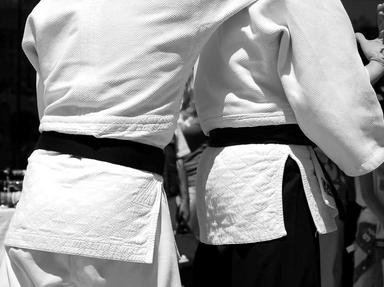Quiz Answer Key and Fun Facts
1. In the early years, the terms "judo" and "jiu-jitsu" (also spelled jujutsu) tended to be used interchangeably, and the sport became best known by the latter name in Brazil while in Japan, the term judo eventually became preferred. Although Brazilian Jiu-Jitsu was developed by a number of people, the main originators are usually considered to be the Gracie brothers who developed it in the 1920s after being trained by what Japanese judo master?
2. Royce Gracie, a Brazilian Jiu-Jitsu practitioner who was the son of Hélio Gracie and grandson of Carlos Gracie, was the inaugural winner in 1993 of which famous mixed martial arts competition that was created to identify the most effective martial art in a contest with minimal rules and no weight classes?
3. In Brazilian jiu-jitsu practice, sparring with other students is known as what?
4. Brazilian jiu-jitsu places greater emphasis on ground fighting than many other martial arts and there are several major ground fighting positions. What is it called when one combatant has their back to the ground while attempting to control the other combatant using their legs?
5. Brazilian jiu-jitsu makes effective use of a number of chokehold techniques derived from judo. What is it called when a fighter encircles an opponent's neck and one of their arms with their legs to press the opponent's arm against their own neck, strangling them?
6. Although Brazilian jiu-jitsu practitioners aim to gain a dominant position over their opponent during grappling, it is also important to know how to escape an opponent's hold if they are currently in a dominant position. One common escape technique involves keeping one's elbows close to one's body and one's hands close together while attempting to roll away from one's opponent, which is known by what crustacean inspired name?
7. Like judo and several other Asian martial arts, Brazilian jiu-jitsu organizations use a system of ranked colored belts to indicate a practitioner's level of proficiency, with experts being awarded black belts. Extremely high-level practitioners who have made a significant contribution to the sport may be awarded a special red-and-black belt that is commonly known by what name, after a poisonous reptile?
8. Legendary martial artist and film star Chuck Norris, among his many other achievements, has a black belt in Brazilian Jiu-Jitsu.
9. Rafael "Barata" de Freitas, a notable black belt from Brazil trained by Carlos Gracie Junior, developed a novel submission technique he calls the "baratoplata," which involves what?
10. Although Brazilian Jiu-Jitsu has long been predominantly practiced by men, women have increasingly become involved in the sport. In 1990, who became the first woman to achieve a black belt in Brazilian Jiu-Jitsu?
Source: Author
agentofchaos
This quiz was reviewed by FunTrivia editor
1nn1 before going online.
Any errors found in FunTrivia content are routinely corrected through our feedback system.
